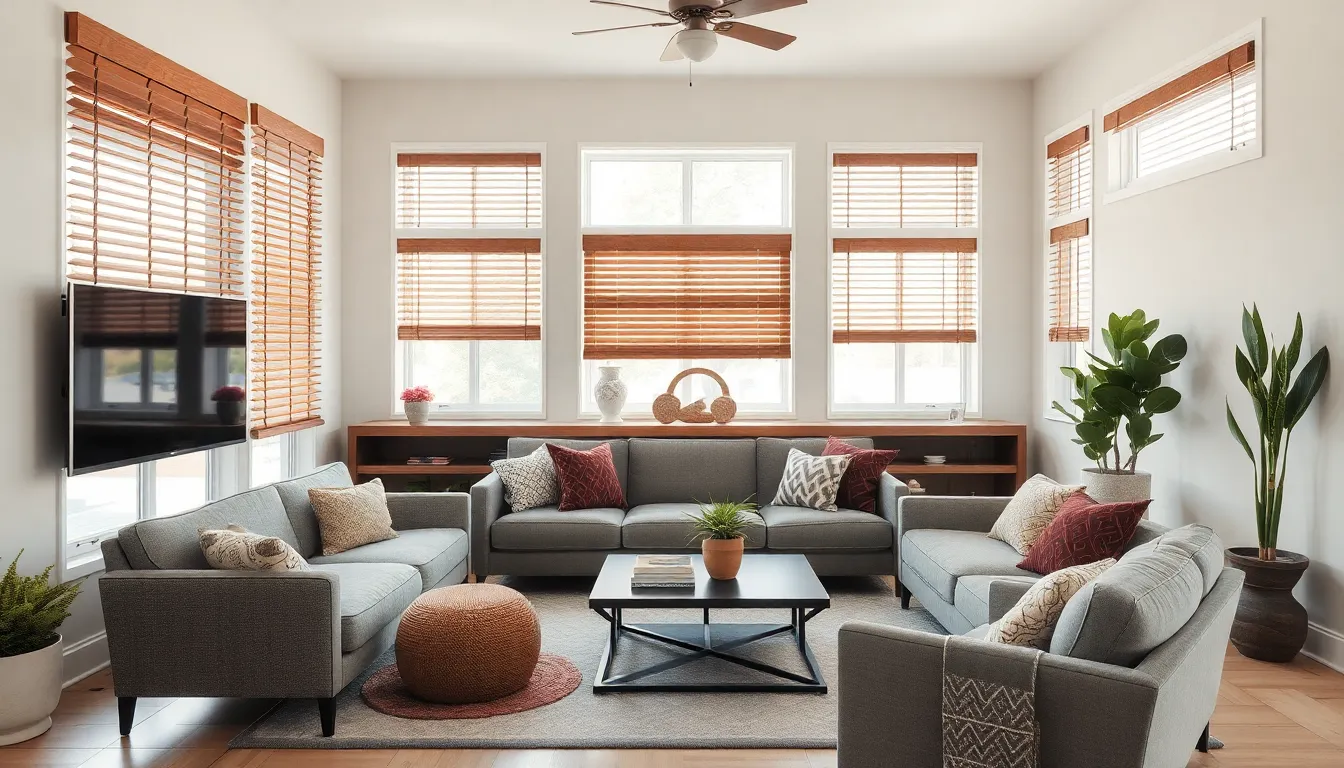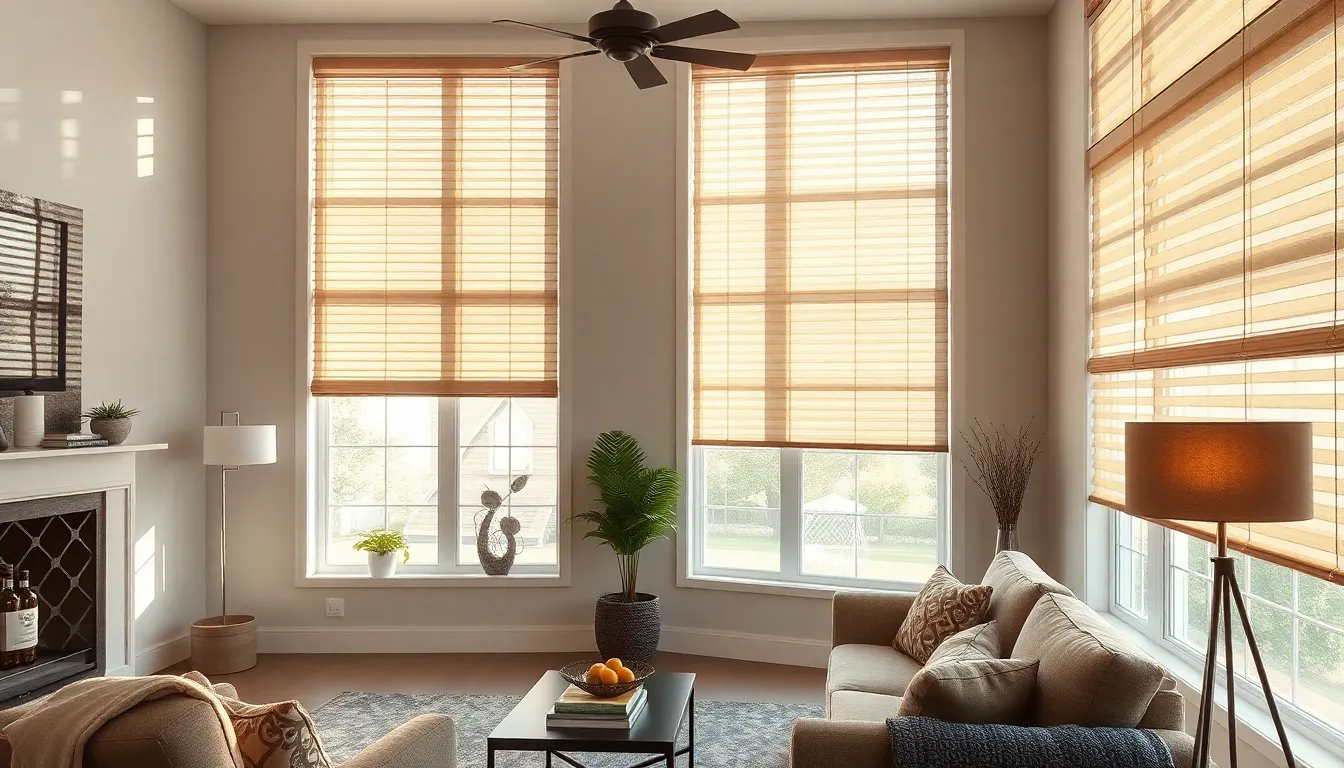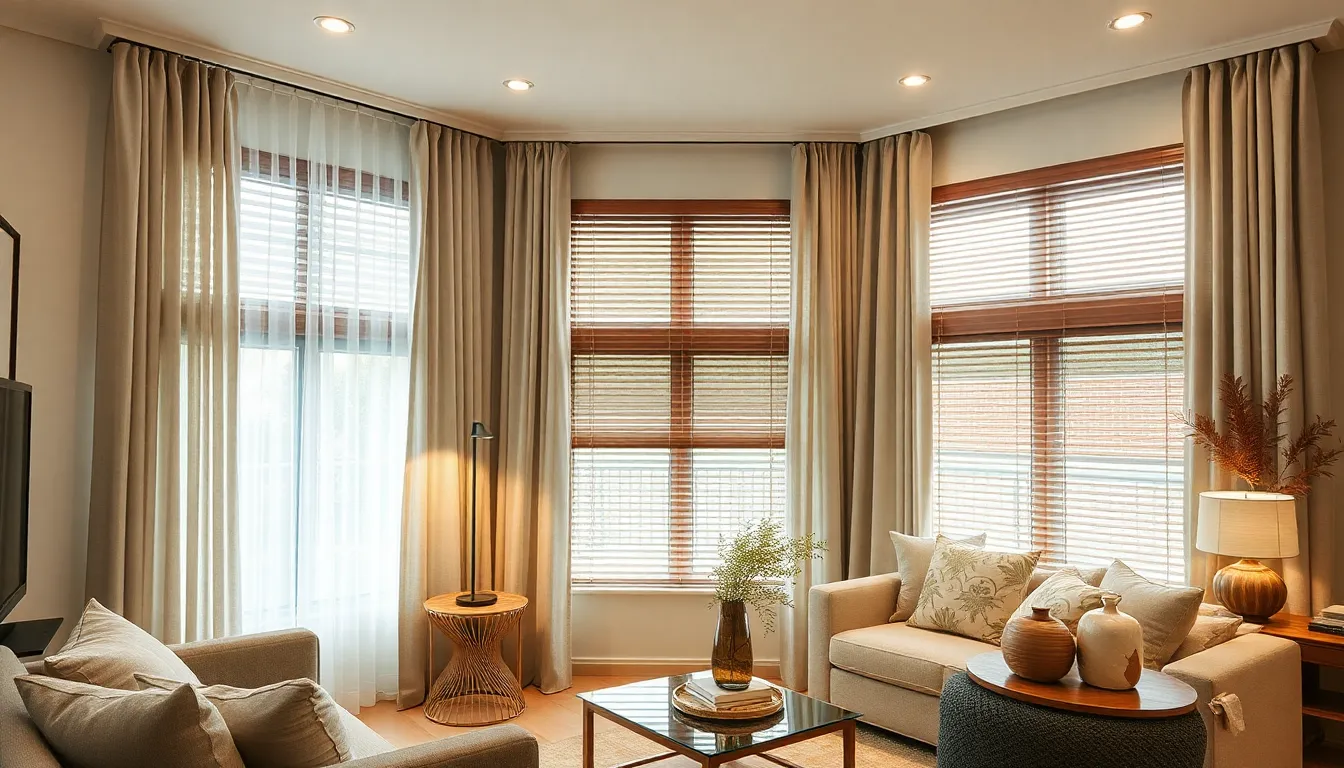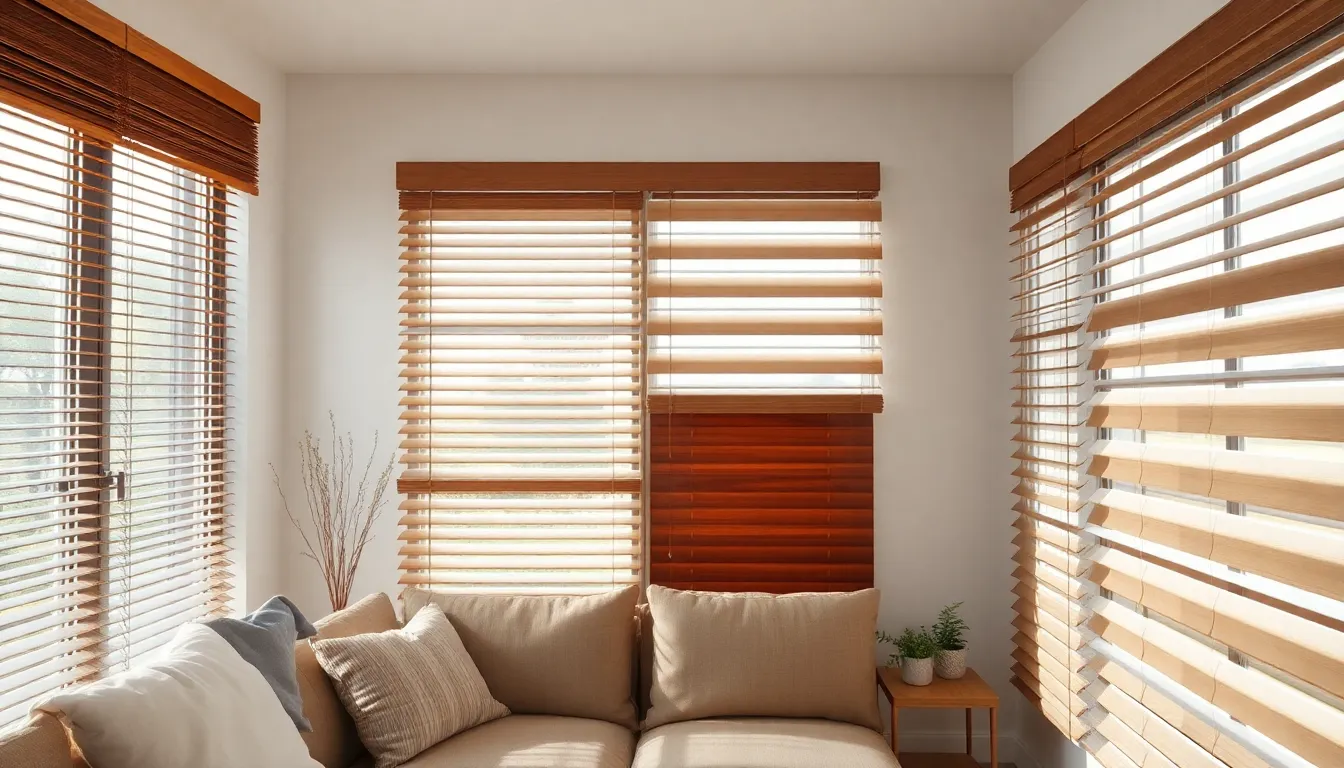We’ve all experienced that moment when sunlight floods our living room at the wrong angle or when we desperately need privacy without sacrificing style. The right blinds can transform your space from ordinary to extraordinary while solving these everyday challenges that impact how we use and enjoy our homes.
Choosing the perfect living room blinds isn’t just about blocking light – it’s about creating an atmosphere that reflects your personality and enhances your daily life. From sleek motorized options that respond to your voice commands to natural bamboo designs that bring warmth and texture we’ll explore answers that work with any budget and aesthetic preference.
Whether you’re dealing with oversized windows that dominate your space or small openings that need strategic enhancement we’ve gathered the most innovative and practical blind ideas to help you make the right choice. Let’s discover how the perfect window treatment can become the finishing touch your living room has been waiting for.
Choose the Right Blind Style for Your Living Room Layout
Your living room’s unique dimensions and window configuration directly influence which blind styles will work best. We’ll explore three critical factors that determine the perfect blind selection for your space.
Consider Room Size and Window Placement
Large living rooms with expansive windows benefit from horizontal blinds that create visual width and make the space feel even more open. Venetian blinds with 2-inch slats work particularly well in rooms over 200 square feet because they provide substantial coverage without overwhelming the space. Vertical blinds excel in rooms with floor-to-ceiling windows or sliding patio doors, drawing the eye upward to emphasize height.
Smaller living rooms require different approaches to avoid visual clutter. Cellular shades or roller blinds with clean lines help compact spaces feel larger by minimizing window treatment bulk. Corner windows in tight layouts work best with inside-mounted blinds that don’t protrude into the room. Bay windows need custom answers like individual blinds for each section or flexible track systems that follow the window’s curve.
Match Blinds to Your Furniture Arrangement
Furniture placement around your windows determines which blind operating mechanisms will function smoothly in daily use. Sectional sofas positioned close to windows need blinds with side controls rather than center pulls to prevent interference with seating. Cordless blinds eliminate entanglement risks when you’ve placed furniture directly beneath windows.
Traditional living room layouts with symmetrical furniture arrangements pair beautifully with matching blind styles on multiple windows. Asymmetrical or modern furniture groupings allow for mixing blind types, such as combining roller shades on smaller windows with plantation shutters on larger focal windows. Entertainment centers and media walls require blackout capabilities, making room-darkening cellular shades or blackout roller blinds essential choices.
Account for Natural Light Requirements
Morning sun exposure through east-facing windows calls for adjustable blinds like aluminum mini blinds or wood blinds that let you control glare during breakfast hours. South-facing living rooms receive intense midday sun, requiring blinds with superior UV protection such as solar shades or dual-cell honeycomb blinds. West-facing rooms need maximum light control during afternoon hours when solar heat gain peaks.
Natural light preservation becomes crucial in north-facing living rooms that receive limited direct sunlight. Sheer blinds or light-filtering cellular shades maintain privacy while maximizing available daylight. Rooms used for television viewing or computer work need blinds with precise light control, making horizontal blinds with adjustable slats the optimal choice for eliminating screen glare.
Select Materials That Complement Your Decor Theme

Choosing the right material for your living room blinds creates the foundation for a cohesive design scheme. We’ll explore three popular materials that align with distinct decorating styles and preferences.
Wood Blinds for Rustic and Traditional Spaces
Wood blinds bring natural warmth and authentic character to rustic and traditional living rooms. These blinds showcase rich grain patterns that add distinction and visual depth to your space. We can customize wood blinds through staining or painting to match other wooden elements like furniture, trim, or flooring throughout the room.
Natural wood options work particularly well in spaces featuring exposed beams, hardwood floors, or vintage furniture pieces. The organic texture and earthy tones create a timeless appeal that complements classic design elements. Wood blinds also provide excellent insulation properties, helping to regulate temperature while maintaining their aesthetic appeal.
Faux Wood Options for Budget-Friendly Elegance
Faux wood blinds deliver the sophisticated appearance of natural wood at a significantly lower cost. These synthetic alternatives resist chipping and fading better than their natural counterparts, making them a practical long term investment. We appreciate their durability and easy maintenance requirements, which include simple dusting and occasional wiping with a damp cloth.
Moisture resistance makes faux wood blinds particularly suitable for living rooms with high humidity levels or those adjacent to kitchens and bathrooms. Unlike natural wood, these blinds won’t warp or deteriorate when exposed to varying moisture conditions. The consistent color and finish ensure your window treatments maintain their fresh appearance for years.
Metal Blinds for Modern and Industrial Looks
Metal blinds perfectly complement contemporary and industrial design themes with their sleek, minimalist appearance. These blinds offer precise light control through various slat sizes and finishes, allowing us to fine tune the ambiance in modern living spaces. The clean lines and metallic surfaces work exceptionally well in rooms featuring concrete, steel, or glass architectural elements.
Different metal finishes provide versatility for matching existing hardware and fixtures throughout the room. Aluminum options remain lightweight and affordable, while steel blinds offer enhanced durability for high traffic areas. The reflective properties of metal surfaces can help bounce natural light deeper into the room, creating a brighter atmosphere.
Coordinate Colors and Patterns With Your Living Room Palette

Creating a cohesive living room design requires careful consideration of how your blinds interact with existing decor elements. We recommend selecting window treatments that complement your furniture, wall colors, and accessories to achieve a harmonious look that enhances your space’s overall aesthetic appeal.
Neutral Tones for Timeless Appeal
Neutral blinds serve as versatile foundations that adapt to changing decor trends while maintaining sophistication. Wood blinds offer natural warmth and can be perfectly matched with existing wood furniture or trim to create visual continuity throughout your living space. Cellular shades provide energy efficiency benefits alongside their neutral color options, making them practical choices that complement any decorating style without overwhelming your room’s design.
We find that neutral tones like beige, cream, and soft gray create calming environments that work beautifully with both contemporary and traditional furniture pieces. These colors ensure your blinds won’t clash with seasonal decorating changes or new accent pieces you might add later.
Bold Colors for Statement-Making Windows
Colorful roller shades transform ordinary windows into striking focal points that energize your living room’s atmosphere. Bold patterns can add incredible visual interest when they contrast thoughtfully with your room’s existing color scheme, drawing attention to architectural features while expressing your personal style preferences.
Statement making windows benefit from vibrant hues like deep navy, rich emerald, or warm terracotta that complement rather than compete with your furniture. We suggest choosing one bold element per room to maintain balance while creating the dramatic impact you’re seeking.
Textured and Patterned Blinds for Visual Interest
Textured shades like woven wood options add depth and dimension to flat wall surfaces, creating layers of visual appeal that enhance your room’s overall design complexity. Roman shades offer soft folds in various fabrics and colors, providing elegant textural elements that bring warmth and sophistication to any living space.
We recommend incorporating textured roller shades or patterned fabrics that echo motifs found elsewhere in your room, such as throw pillows or area rugs. This approach creates intentional design connections that make your space feel thoughtfully curated rather than randomly assembled.
Optimize Light Control for Different Times of Day

Effective light management transforms your living room’s functionality throughout different periods. We’ll explore strategic blind answers that adapt to changing lighting needs while maintaining style and comfort.
Room-Darkening Blinds for Movie Nights
Room darkening shades significantly reduce light without achieving complete blackout conditions. These window treatments prevent glare on television screens and enhance your movie watching experience by creating the ideal viewing environment. Sound absorbing materials in many room darkening options contribute to a more immersive home theater atmosphere by reducing external noise interference.
We recommend installing these shades in living rooms where you want to maintain some ambient light while controlling brightness levels. Media rooms benefit particularly from this type of light control since complete darkness isn’t always necessary for comfortable viewing. The versatility of room darkening blinds makes them perfect for spaces that serve multiple functions beyond entertainment.
Light-Filtering Options for Ambient Lighting
Solar screens allow natural light to filter through while reducing glare and heat gain from direct sunlight. These window treatments maintain a bright and airy atmosphere in your living space without compromising comfort during peak sun hours. Sheer shades provide soft, diffused lighting that creates a cozy ambiance while still permitting daylight to enter your room.
Light filtering blinds work exceptionally well in living rooms where you want to preserve natural illumination throughout the day. We find these options ideal for spaces where harsh sunlight creates uncomfortable conditions but complete light blocking isn’t desired. The gentle lighting effect enhances relaxation while protecting furniture and flooring from UV damage.
Top-Down Bottom-Up Blinds for Privacy and Light
Top down bottom up shades offer flexibility by allowing light to enter from either the top or bottom portions of your windows. This dual functionality provides both privacy protection and customizable light control simultaneously throughout different times of day. Dual function blinds combine light filtering capabilities with blackout options, offering remarkable versatility in managing both illumination and privacy needs.
We appreciate how these innovative designs solve common living room challenges by permitting natural light while maintaining privacy from street level views. Adjustable panels can be positioned to optimize lighting conditions while blocking unwanted sight lines from neighbors or passersby. The strategic control over light entry points makes these blinds particularly valuable for ground floor living rooms or spaces facing busy areas.
Layer Blinds With Curtains for Enhanced Style

Combining blinds with curtains creates a sophisticated layered look that transforms your living room windows into stunning focal points. This versatile approach allows for precise control over light and privacy while adding depth and visual interest to your space.
Sheer Curtains Over Blinds for Softness
Adding sheer curtains over your existing blinds instantly softens the overall appearance of your living room. These delicate fabrics filter natural sunlight beautifully, creating a warm and inviting ambiance that makes your space feel more welcoming. We recommend choosing sheers in neutral tones like ivory or soft white to complement any color scheme, though subtle patterns can add gentle visual texture without overwhelming your design.
Sheer panels maintain your privacy while still allowing filtered light to illuminate your room throughout the day. Installing them on separate rods gives you complete flexibility to adjust each layer independently, letting you customize the lighting and privacy levels to match your daily activities.
Valances and Cornices for Finished Looks
Valances and cornices add the perfect finishing touch to your layered window treatments by covering the hardware and creating a polished, intentional appearance. Valances drape gracefully across the top of your windows, offering a softer approach that works well with traditional and transitional decor styles. Structured cornices provide a more customized look that complements modern and contemporary living rooms beautifully.
We suggest selecting materials that coordinate with your existing furniture and decor elements. Fabric valances can incorporate patterns or textures that echo your throw pillows or upholstery, while wooden cornices can match your furniture finishes for a cohesive design flow.
Combining Different Textures and Colors
Mixing textures and colors strategically transforms your blinds into ever-changing design elements that enhance your living room’s visual appeal. Pairing smooth roller blinds with textured curtain panels creates an captivating contrast that adds depth and sophistication to your windows. We’ve found that combining wooden blinds with linen or cotton curtains brings natural warmth while maintaining clean, contemporary lines.
Bold patterned fabrics work exceptionally well for adding visual interest in neutral living rooms, while coordinating wood tones between your blinds and furniture creates a harmonious, well planned aesthetic. Consider incorporating metallic accents through curtain hardware or blind components to tie your window treatments into other room elements like lighting fixtures or decorative accessories.
Install Smart Blinds for Modern Convenience

Smart blinds represent the perfect fusion of technology and window treatments, transforming how we interact with natural light in our living spaces. These innovative answers offer unparalleled convenience while maintaining the aesthetic appeal we’ve established through our material and design choices.
Motorized Options for Easy Operation
Automated scheduling transforms your daily routine by eliminating the need for manual blind adjustments throughout the day. We can program these systems to open gradually in the morning and close at sunset, creating a natural rhythm that enhances our living experience.
Cordless operation significantly improves household safety by removing traditional pull cords that pose risks to children and pets. This feature becomes particularly valuable in family living rooms where safety concerns often influence our design decisions.
Smartphone app control provides hands-free convenience that integrates seamlessly with our busy lifestyles. We can adjust lighting conditions without leaving our comfortable seating arrangements, especially beneficial when entertaining guests or during movie nights.
Smart Home Integration Features
Seamless connectivity with existing smart home systems allows our blinds to communicate with other automated devices throughout the house. We can create comprehensive scenes that adjust lighting, temperature, and window treatments simultaneously for optimal comfort.
Energy efficiency optimization reduces utility costs by automatically positioning blinds to minimize artificial lighting needs and regulate indoor temperatures. This intelligent positioning helps us maintain consistent comfort levels while reducing our environmental impact.
Voice control compatibility with popular assistants like Alexa and Google Home enables effortless operation through simple verbal commands. We can adjust our blinds while cooking, cleaning, or relaxing without interrupting our activities.
Remote Control and App Connectivity
Smartphone accessibility from any location provides complete control over our living room environment even when we’re away from home. This feature proves invaluable for maintaining privacy and security while traveling or working late.
Customizable automated settings adapt to changing light conditions throughout different seasons and times of day. We can program exact positions for morning coffee, afternoon reading, or evening entertainment without manual intervention.
Security simulation features enhance home protection by creating the appearance of occupancy when we’re away. These programmed movements deter potential intruders while maintaining our home’s natural lighting patterns, providing peace of mind during extended absences.
Consider Budget-Friendly DIY Living Room Blind Ideas

Transforming your living room blinds doesn’t require a complete overhaul or expensive professional installation. Creative DIY approaches can refresh existing window treatments while keeping costs minimal.
Upcycling Old Blinds With Paint and Fabric
Painted blinds offer an instant refresh that modernizes outdated window treatments without replacement costs. We recommend using spray paint or high-quality acrylic paint to coat wooden or metal blinds in trending colors that complement your living room palette. Light colors like white or cream make rooms appear larger, while bold accent colors create striking focal points.
Fabric wrapping transforms tired blinds into custom designer pieces by adding texture and visual interest to each slat. Simply cut fabric strips slightly wider than your blind slats and attach using spray adhesive or double-sided tape. Choose patterns that coordinate with your existing throw pillows or upholstery to create cohesive design connections throughout the space.
No-sew drop cloth curtains provide another budget-friendly solution using basic curtain rings with clips for quick installation. Drop cloths from hardware stores cost significantly less than traditional curtain fabric while offering neutral tones that work with various decorating styles.
Creating Custom Valances and Tie-Backs
DIY Roman shades created from old mini blinds deliver sophisticated window treatments at fraction of retail prices. Attach fabric panels to existing blind mechanisms to achieve the polished look of custom Roman shades while maintaining functional light control. This approach transforms basic horizontal blinds into elegant focal points that enhance any living room aesthetic.
Custom valances using coordinating fabric add professional finishing touches that hide blind hardware and create seamless design flow. We suggest measuring your window width plus 4-6 inches for proper coverage, then selecting fabric that matches or complements your room’s color scheme. Simple box valances require minimal sewing skills while delivering maximum visual impact.
Fabric tie-backs offer decorative functionality by holding curtains or drapes in position while adding textural elements to window treatments. Create matching sets using leftover upholstery fabric or contrasting materials that introduce new colors into your living room design.
Installing Blinds Yourself to Save Money
DIY installation eliminates professional installation fees while giving you complete control over timing and placement accuracy. Most blind installations require basic tools like drills, levels, and measuring tapes that homeowners already possess. Online tutorials provide step-by-step guidance for installing different blind types, from simple roller shades to complex motorized systems.
Measuring accurately before purchasing blinds prevents costly returns and ensures proper fit within window frames. We recommend measuring width at three points (top, middle, bottom) and using the smallest measurement for inside mount installations. Outside mount blinds require additional width to ensure adequate light blocking and privacy coverage.
Self-installation typically saves $50-150 per window compared to professional services, making it particularly cost-effective for multiple window projects. Take time to understand manufacturer instructions and don’t rush the process to achieve professional-looking results that enhance your living room’s overall appearance.
Maintain Your Living Room Blinds for Longevity

We believe proper maintenance is essential for keeping your living room blinds looking their best and functioning smoothly for years to come. Regular care not only preserves their appearance but also protects your investment in quality window treatments.
Regular Cleaning Schedules by Material Type
Wood Blinds require gentle dusting with a dry cloth at least once weekly to prevent buildup that can damage the natural finish. We recommend testing wood-friendly cleaners on an inconspicuous area before treating any stains or spots. Monthly deep cleaning with specialized wood polish helps maintain their rich appearance and prevents cracking.
Fabric Blinds need careful attention since they attract dust and allergens more readily than other materials. Gentle vacuuming with a brush attachment works best for weekly maintenance, while deeper cleaning every few months requires mild detergent testing first. We suggest using a soft microfiber cloth for delicate fabrics to avoid snags or tears.
Vinyl and Metal Blinds offer the easiest maintenance routine, requiring only a damp cloth with mild soap for weekly cleaning. These durable materials can handle more frequent cleaning without damage, making them ideal for high-traffic living rooms. We avoid harsh chemicals that can cause discoloration or deterioration over time.
Repair Tips for Common Blind Issues
Broken Slats can be replaced individually without replacing the entire blind system. We carefully remove the damaged slat by sliding it out of the ladder strings and insert the new one, ensuring proper alignment with surrounding slats. This simple repair extends the life of your blinds significantly.
Tilt Mechanism Problems often stem from loose screws or misaligned internal parts that affect smooth operation. We check all mounting hardware regularly and tighten connections as needed to prevent further damage. Lubricating moving parts with appropriate cleaners helps maintain smooth tilting action.
Cord Malfunctions typically involve tangles or knots that interfere with raising and lowering functions. We inspect cords thoroughly for wear spots or fraying that could lead to complete failure. Cord cleaners can restore smooth operation, while replacement cords offer a long-term solution for severely damaged systems.
When to Replace vs. Restore Your Blinds
Replacement becomes necessary when blinds show important structural damage, outdated styling, or complete functional failure that repair can’t address. We evaluate the cost of extensive repairs against new blind prices to make informed decisions. Safety concerns with cord systems or mounting hardware also warrant immediate replacement.
Restoration works best for blinds with minor cosmetic issues or simple mechanical problems that don’t affect structural integrity. We often recommend repainting wooden blinds or replacing fabric panels to refresh their appearance without full replacement costs. Regular maintenance combined with targeted repairs can extend blind life by several years.
Conclusion
Finding the perfect blinds for your living room doesn’t have to be overwhelming when you focus on what matters most to your space. We’ve covered everything from material choices and color coordination to smart technology and budget-friendly DIY answers.
Remember that the best window treatments balance style with functionality while reflecting your personal taste. Whether you choose natural wood for warmth or sleek metal for a modern edge your blinds should enhance your daily living experience.
Take time to consider your room’s unique lighting needs and window configurations before making your final decision. With proper care and maintenance your chosen blinds will serve as both practical window coverings and beautiful design elements for years to come.
Frequently Asked Questions
What factors should I consider when choosing blinds for my living room?
Consider three key factors: room size and window placement, furniture arrangement, and natural light requirements. Large rooms benefit from horizontal or vertical blinds to enhance space, while smaller rooms work better with cellular shades or roller blinds. Choose cordless options if furniture sits close to windows, and select materials based on your window’s orientation and light management needs.
What are the best blind materials for living rooms?
The three most popular materials are wood, faux wood, and metal. Wood blinds offer natural warmth and work well in rustic or traditional spaces. Faux wood provides durability and moisture resistance at a lower cost. Metal blinds suit modern and industrial designs with sleek aesthetics and precise light control.
How do I coordinate blind colors with my living room decor?
Select colors that complement your existing furniture and wall colors. Neutral tones like beige and cream offer timeless appeal and versatility. Bold colors can serve as statement pieces to energize the space. Consider textured and patterned blinds to add visual interest while maintaining design cohesion throughout your living area.
What are the best blinds for light control in living rooms?
Room-darkening blinds reduce light without complete blackout, perfect for movie watching. Light-filtering options like solar screens and sheer shades maintain brightness while reducing glare and UV damage. Top-down bottom-up blinds offer flexible privacy and customizable light control, ideal for rooms facing busy areas.
Can I layer blinds with other window treatments?
Yes, layering blinds with curtains creates sophisticated style and enhanced functionality. Use sheer curtains over blinds to soften the room’s appearance while filtering light. Add valances or cornices to cover hardware and provide a polished finish. Mix textures and colors to create visual interest and coordinate with existing decor.
What are the benefits of smart blinds for living rooms?
Smart blinds offer motorized operation with automated scheduling, eliminating manual adjustments. They provide cordless safety benefits for families and smartphone app control for convenience. Integration with smart home systems enables energy efficiency optimization, while remote control capabilities and security simulation features enhance both comfort and home protection.
How can I update my living room blinds on a budget?
Try DIY approaches like upcycling old blinds with paint and fabric, creating custom valances and tie-backs, or installing blinds yourself. These methods can refresh existing window treatments while maintaining style and functionality, allowing you to achieve professional-looking results without expensive installation costs.
How do I maintain different types of blinds?
Maintenance varies by material. Wood blinds need gentle dusting and occasional conditioning. Fabric blinds require regular vacuuming and spot cleaning. Vinyl blinds can be wiped with damp cloths, while metal blinds need frequent dusting. Establish cleaning schedules based on your blind material to ensure longevity and optimal appearance.
When should I repair versus replace my living room blinds?
Evaluate repair costs against replacement prices. Simple issues like broken slats or tilt mechanism problems are often worth fixing. However, if repairs exceed 50% of replacement cost, or if blinds show extensive wear, fading, or multiple problems, investing in new blinds is more cost-effective long-term.







